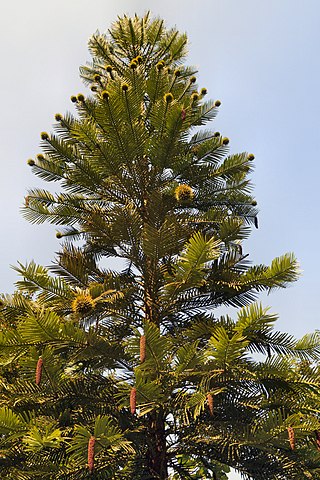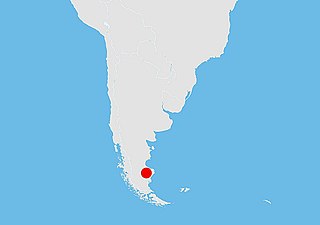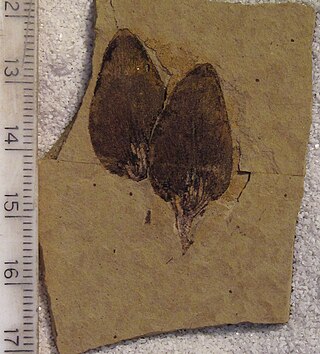
Araucaria araucana, commonly called the monkey puzzle tree, monkey tail tree, piñonero, pewen or pehuen pine, is an evergreen tree growing to a trunk diameter of 1–1.5 m (3.3–4.9 ft) and a height of 30–40 m (98–131 ft). It is native to central and southern Chile and western Argentina. It is the hardiest species in the conifer genus Araucaria. Because of the prevalence of similar species in ancient prehistory, it is sometimes called an animate fossil. It is also the official tree of Chile and of the neighboring Argentine province of Neuquén. The IUCN changed its conservation status to Endangered in 2013 as logging, forest fires, and grazing caused its population to dwindle.

Araucariaceae is a family of conifers with three living genera, Araucaria, Agathis, and Wollemia. While the family's native distribution is now largely confined to the Southern Hemisphere, except for a few species of Agathis in Malesia, it was formerly widespread in the Northern Hemisphere during the Jurassic and Cretaceous periods.

Wollemia is a genus of coniferous trees in the family Araucariaceae, endemic to Australia. It represents only one of three living genera in the family, alongside Araucaria and Agathis. The genus has only a single known species, Wollemia nobilis, commonly known as the Wollemi Pine which was discovered in 1994 in a temperate rainforest wilderness area of the Wollemi National Park in New South Wales. It was growing in a remote series of narrow, steep-sided, sandstone gorges 150 km (93 mi) north-west of Sydney. The genus is named after the National Park.

Araucaria is a genus of evergreen coniferous trees in the family Araucariaceae. While today they are largely confined to the Southern Hemisphere, during the Jurassic and Cretaceous they were globally distributed. There are 20 extant species in New Caledonia, eastern Australia, New Guinea, Argentina, Brazil, Chile and Uruguay.

Agathis, commonly known as kauri or dammara, is a genus of evergreen coniferous trees, native to Australasia and Southeast Asia. It is one of three extant genera in the family Araucariaceae, alongside Wollemia and Araucaria. Its leaves are much broader than most conifers. Kauri gum is commercially harvested from New Zealand kauri.

Araucaria bidwillii, commonly known as the bunya pine, banya or bunya-bunya, is a large evergreen coniferous tree in the family Araucariaceae which is endemic to Australia. Its natural range is southeast Queensland with two very small, disjunct populations in northeast Queensland's World Heritage listed Wet Tropics. There are many planted specimens on the Atherton Tableland, in New South Wales, and around the Perth metropolitan area, and it has also been widely planted in other parts of the world. They are very tall trees – the tallest living individual is in Bunya Mountains National Park and was reported by Robert Van Pelt in January 2003 to be 51.5 m (169 ft) in height.

Cunninghamia is a genus of one or two living species of evergreen coniferous trees in the cypress family Cupressaceae. They are native to China, northern Vietnam and Laos, and perhaps also Cambodia. They may reach 50 m (160 ft) in height. In vernacular use, it is most often known as Cunninghamia, but is also sometimes called "China-fir". The genus name Cunninghamia honours Dr. James Cunningham, a British doctor who introduced this species into cultivation in 1702 and botanist Allan Cunningham.

Araucarioxylon arizonicum is an extinct species of conifer that is the state fossil of Arizona. The species is known from massive tree trunks that weather out of the Chinle Formation in desert badlands of northern Arizona and adjacent New Mexico, most notably in the 378.51 square kilometres Petrified Forest National Park. There, these trunks are locally so abundant that they have been used as building materials.

Williamsonia is a genus of plant belonging to Bennettitales, an extinct order of seed plants. Within the form classification system used in paleobotany, Williamsonia is used to refer to female seed cones, which are associated with plants that also bore the male flower-like reproductive structure Weltrichia.
La Matilde Formation is a Jurassic geological formation in the Austral Basin of Santa Cruz Province, Patagonia, Argentina. It is dated to the Middle to Late Jurassic. From the Bathonian age to the Kimmeridgian age at the latest.

Araucarites sanctaecrucis is an extinct coniferous tree from Patagonia, Argentina. Its exact affinities are unknown and it is currently assigned to the form genus Araucarites of the family Araucariaceae. A. sanctaecrucis are known from petrified fossils of branches, foliage, and cones from the Cerro Cuadrado Petrified Forest.

Mary Gordon Calder was a Scottish paleobotanist. She is known for her work on Carboniferous fossil plants and Jurassic conifers.

Brachyphyllum is a form genus of fossil coniferous plant foliage. Plants of the genus have been variously assigned to several different conifer groups including Araucariaceae and Cheirolepidiaceae. They are known from around the globe from the Late Carboniferous to the Late Cretaceous periods. The type species B. sattlerae was named after the fictional palaebotanist Ellie Sattler from the Jurassic Park franchise.

The Jaramillo Petrified Forest National Park is a protected area of petrified forest located in the Deseado Department, in the northeast of Santa Cruz Province, Argentina. Formerly part of the site was a natural monument, established in 1954 and known as the Petrified Forest Natural Monument, covering about 13,700 hectares. This area has remnants of a forest preserved in stone, that had been growing on the site before the upthrust of the Andes some 150 million years ago. In December 2012, further land was added and the protected area was reclassified as a national park with a total area of 78,543 hectares.
Araucaria haastii is an extinct species of conifer tree formerly native to New Zealand. A large number of fossilised tree specimens from the family Araucariaceae have been found in New Zealand, but in many cases the level of preservation is not sufficient to reliably distinguish between Araucaria species and Agathis species.

"Agathis" jurassica is an extinct coniferous tree found in the Talbragar Fish Beds of New South Wales. The beds were discovered in 1889 near the Farrs Hills in the Talbragar River valley. Specimens from the area were briefly examined by Australian palaeontologists upon discovery and published by R. Etheridge Jr. later that year. The initial classification identified Agathis jurassica as Podozamites lanceolatus. This name was upheld through further inspections by Walkom in 1921, but the species was reclassified as Agathis jurassica in 1981 by Mary White. In 1999, placement in Agathis was doubted, and the species has been referred to as Podozamites jurassica. The species is found predominantly in the Southern Hemisphere with marginal expanses into the Northern Hemisphere.
Eathiestrobus mackenziei is a fossil pine cone found in the Kimmeridge Clay Formation near Eathie, on the Black Isle in Scotland. It is the oldest fossil pine currently known.

Pseudolarix wehrii is an extinct species of golden larch in the pine family (Pinaceae). The species is known from early Eocene fossils of northern Washington state, United States, and southern British Columbia, Canada, along with late Eocene mummified fossils found in the Qikiqtaaluk Region, Nunavut, Canada.

Pararaucaria is a genus of conifer cone belonging to the extinct family Cheirolepidiaceae. Fossils are known from the Lower Jurassic to Early Cretaceous of North America, Europe, South America and Asia. It is associated with Brachyphyllum-type foliage.
Araucarioides is an extinct genus of conifer belonging to the family Araucariaceae. The type species Araucarioides linearis is known from the Early Eocene of Tasmania, with fossils including isolated leaves, parts of the conifer cone, as well as possible seeds, associated with Dilwynites tuberculatus pollen. Another species only known from leaves, Araucarioides falcata is known from the Late Cretaceous (Campanian) of New Zealand. Phylogenetic analysis suggests that Araucarioides linearis is closely related to both Agathis and Wollemia rather than to Araucaria.



















